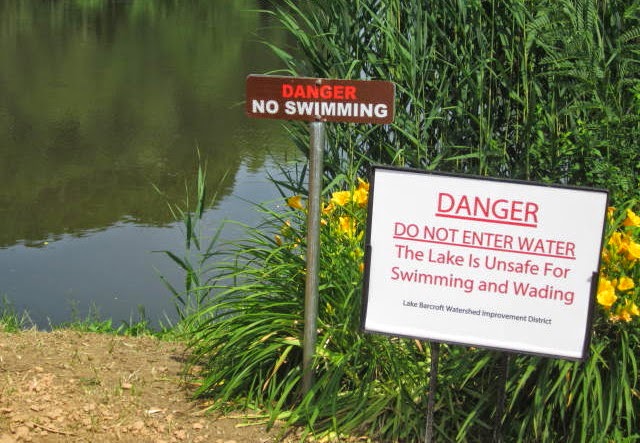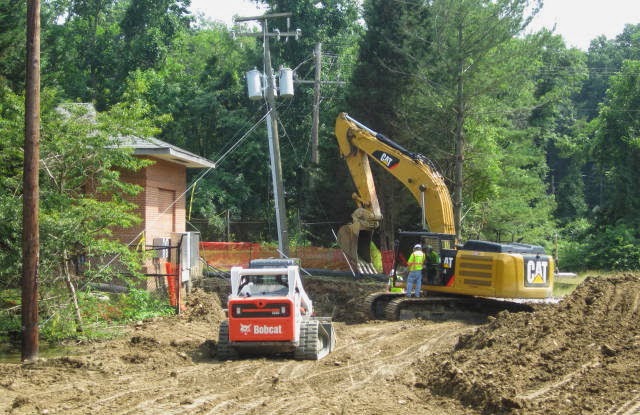Lake Barcroft contaminated with sewage for the fourth time this year
 |
| A warning sign posted at Lake Barcroft by the Watershed Improvement District. |
Don’t swim in Lake Barcroft—and keep your children and pets away from the water, too. There’s been another sewage spill into the lake; it’s the fourth spill since April 29. Beaches 1-4 are closed. Only Beach 5, which is upstream from the spill, is open.
About 6,000 gallons of raw sewage spilled from the Holmes Run Pumping Station on the corner of Dearborn Drive and Sleepy Hollow Road into Holmes Run on June 16, reports an update on the Lake Barcroft community website.
“This is less than the 300,000 to 400,000 gallons of sewage and stormwater runoff that spilled into the lake from this same point during the April 30 storm,” the notice states, “but it is nearly twice as much raw sewage as the May 16 spill from this same point and the May 19 spill from the pumping station at Beach 3.”
Mason Supervisor Penny Gross
has organized a meeting for the Lake Barcroft community with county
wastewater management staff June 25, 7:30 p.m., at the Mason District
Government Center.
According to Irene Haske, a spokesperson for the Stormwater, Wastewater, and Urban Forestry divisions in the Fairfax County Department of Public Works and Environmental Services, the spill occurred when work crews were diverting the flows to the pump station to allow for inspection of the gravity line.
 |
| The pump station on Sleepy Hollow Road and Dearborn Drive. |
“When the pumps came on, the crews noted sewage coming up through the ground, indicating a leak from the force main serving this pump station,” she says. “The pump station was shut off; flows were diverted back to the gravity line and clean-up operations began.”
The force main had been repaired and tested after the April 29 spill and had been operational for about a month, Haske notes. “Crews are currently digging the pipe up to determine what failed and why. After each event the county undertook water testing at several locations above, below, and around the lake.”
Del. Kaye Kory, who lives on Lake Barcroft, doesn’t believe the county has done enough to notify residents about the unsafe water. During the previous sewage spill, she complained about the small signs with small type, and bigger signs appeared. Although the incidents were reported on the Lake Barcroft website and LakeLink, community email system, she says, lots of people were still likely to be unaware of what happened.
It’s also not known whether residents downstream from the dam, along Holmes Run Stream Valley Park were notified about any of these incidents.
The first sewage spill at Lake Barcroft this year occurred during a major rainstorm on April 29. “At this time the county was in the midst of rehabilitating the force main serving the Holmes Run pump station, and the temporary pump-around to allow this work was overwhelmed by the intensity of the storm,” Haske says. “The county had tried to get the station back in service immediately before the storm, but a connection on the force main had failed during testing. This force main connection was repaired immediately.”
The county estimates that about 80 percent of the 300,000 to 400,000 gallons discharged from the sanitary sewer system during that incident was rain water entering the system. “During this event, the flows over the Barcroft dam were measured in excess of 500,000 gallons per minute,” Haske says.
The second spillage occurred during the storm on May 15 and 16, when the pumps at that station failed to turn on, Haske says. Crews adjusted the electrical controls on the pump to reduce the overflow. Approximately 3,200 gallons were discharged, and the flows over the dam at that time were measured at 1.2 million gallons per minute.
The third event occurred at a different pump station located near Beach 3 on May 18. A controller in the station malfunctioned, and it was not immediately detected because the previous storm had disabled the telephone lines used for automated reporting of pump station malfunctions to the county’s maintenance crews, Haske says.
The spillage occurred after crews physically checked the pumping stations that weekend and determined they were in good working condition. The overflow from that spill was estimated at 3,900 gallons. “Since this event, an automated, wireless backup communication system has been installed in the station to report any malfunctions to the county’s maintenance crews,” Haske says.


Test results show “no detectable levels of human bacteria” in the water samples taken off each of the beaches, a notice posted on the Lake Barcroft website June 19 states. The beaches have been reopened, and people can swim in the lake. Bacteria results were higher in the water directly off the Woman’s Club Garden (although still well within state standards for swimming), so the “no swimming sign” is still up in that area.
While this is all very interesting from an environmental perspective, people should keep in mind that Lake Barcroft is a private lake. Anyone who isn't a Lake Barcroft resident or in the company of a Lake Barcroft resident is a trespasser – whether they are swimming, ice skating, fishing, boating, or just enjoying the view. Therefore, except for those of us affected by the unexplored downstream impacts from the spills, most people are completely unaffected by these events if they simply respect the property rights of those who pay taxes to the Lake Barcroft Watershed Improvement District. And yes, trespassers can be prosecuted. Maybe that realtor who was attacked by a rabid beaver last year would have preferred being arrested.
P.S. – It's a "dam", not a "damn".
oops – fixed it.
of course, interesting from an environmental point of view. But even more interesting is these questions: do you really think these health hazards created by failures of aging infrastructure are restricted to Lake Barcroft?
And when water is declared 'safe' that stops long-term environmental effects?